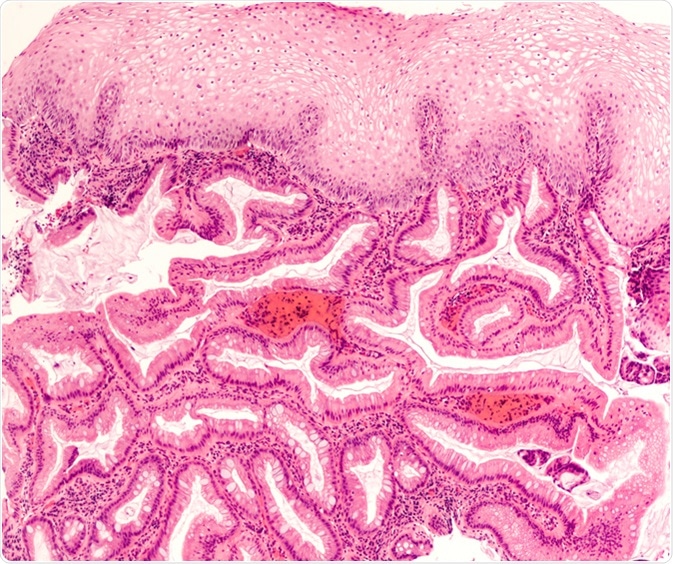https://alternative-medicine-doctors.com/top/buy-cheap-advair-nz-no-prescription/
Although epidemiologic studies point to environmental factors, obesity, smoking, esophageal reflux, and diet as the main causes of Barrett’s esophagus (BE), there is growing evidence of a genetic predisposition as well. It is now fairly clear that the role of genetics is greatest in the initial stages of the disease.

A number of research studies on this subject have concluded that three genes are primarily responsible for this condition. These genes are thought to play a vital role in increasing the risk of Barrett’s esophagus following their transformation or mutation. These are CTHRC1, ASCC1, and MSR1, also called the predisposition genes, as they do not actually cause Barrett’s esophagus unless in mutated form.
Genes Responsible for Barrett's Esophagus (BE)
The germline mutations in the predisposition genes cause the progress of esophageal disorders. Also, the mutations in the MSR1, CTHRC1, and ASCC1 genes are associated with BE and esophageal adenocarcinoma (p<0.001). BE is typically identified only in the terminal phase, which endangers the patient severely. Esophageal carcinomas arise from the pre-existing condition of BE, which in turn develops as a result of chronic gastroesophageal reflux which produces chronic inflammation.
MSR1 gene: The MSR1 gene encodes the A class scavenger macrophage receptors that include Type 1, Type 2, and Type 3. All the aforementioned types are due to random splicing of the MSR1 gene. These isoforms are macrophage-specific integral glycoproteins of the cell membrane and have been associated with several macrophage-associated pathological and physiological processes. These include atherosclerosis, host defenses, and Alzheimer’s disease. Type 1 and Type 2 genotypes are known as the operative receptors, which are capable of intermediating the modified low density lipoproteins (LDLs) in endocytosis. The position of the MSR1 gene is on the short arm (p) of chromosome 8 at position 22 (8p22).
ASCC1 gene: The ASCC1 gene encodes a subunit that activates the signal co-integrator 1 (ASC-1). The ASC-1 complex is defined as the transcriptional co-activator that performs a vital role in transactivation of the gene through multiple transcription elements comprising protein 1 called AP-1, serum factor (SRF), and nuclear factor kappa-B. All these encoded proteins carry an N-terminal KH-type RNA-binding motif that is important for AP-1 transactivation through ASC-1 complex. Mutations in this gene are associated with both esophageal adenocarcinoma and Barrett’s esophagus. Spliced transcripts encode multiple isoforms. The ASCC1 gene is located on the long arm (q) of chromosome 10 at position 22.1 (10q22.1).
CTHRC1 gene: The CTHRC1 gene is a locus that encodes the protein that plays a vital role in response to arterial cellular injury by vascular remodeling. Mutations of this gene locus are associated with Barrett’s esophagus and esophageal adenocarcinoma. They may act as negative regulators of the collagen matrix homeostasis. This gene is located on the long arm (q) of chromosome 8 at position 22.3 (8q22.3).
Differential analytic techniques such as integrative genomic, single-SNP, and haplotype analysis generated 12 potential genes for future identification of gene mutations. The chromosome that contains the MSR1 gene encodes scavenger receptors which may be involved in pathologic inflammation and apoptosis.
Apart from the truncating MSR1 c.877C>T mutation that has been identified in patients, another separate MSR1 germline mutation (c.760C>G, p.L254V) has been found in some patients. The ratio of occurrence of these gene mutations is estimated as 0.017 (95% 0.021 to 0.061, P=0.19). Furthermore, there were two other mutations identified, one of which is located on ASCC1 (c.869A>G, p.N290S) and the other on CTHRC1 (c.131A>C, p.Q44P).
Genetic Code Involved in Barrett's Esophagus (BE)
Inherited BE: First- or second-degree relatives of patients affected with BE, adenocarcinoma on the gastroesophageal junction, or esophageal adenocarcinoma (EAC) have increased risk of developing inherited BE. It has been identified from recent work that the risk of BE may be increased by a rare autosomal dominant susceptibility mutation in affected families. The exact mutation is still unidentified.
Sporadic Barrett’s esophagus: The primary risk factors of the Barrett’s esophagus include age, gender (male), the presence of gastroesophageal reflux disorder (GERD), and skin tone (white-skinned people). Obesity and GERD are known to be the most predictive factors for the development of genetic BE. GERD is a primary risk factor for BE. Sporadic cases have been found where patients are found to inherit GERD as well as BE. Many studies have confirmed that families affected by BE might actually have a GERD-related genetic component.
The mechanism of obesity in the development of BE is not clearly defined, but it is found to increase the risk of GERD. Obesity-induced increases in signaling through certain insulin-like growth factor pathways which favor proliferation, and through insulin pathways, may be involved as well in the etiology of BE.
Patients with obesity, either with or without BE, have been studied to determine the IGF-1R genotype. It was found that obese patients with BE had the pro-proliferative IGF-1R genotype more commonly than those without BE or GERD.
References
- https://deepblue.lib.umich.edu/bitstream/handle/2027.42/86844/j.1749-6632.2011.06043.x.pdf
- https://www.cancer.org/treatment/understanding-your-diagnosis/tests/understanding-your-pathology-report/esophagus-pathology/barrets-esophagus.html
- http://www.adasp.org/FAQs/02-esoph.html
- http://www.gastro.org/info_for_patients/barrett-s-esophagus-107-low-grade-dysplasia-in-barrett-s-esophagus
- http://surgpathcriteria.stanford.edu/gi/barrett-esophagus/dysplasia.html
- http://onlinelibrary.wiley.com/doi/10.1111/j.1365-2796.2011.02400.x/pdf
- https://rarediseases.info.nih.gov/diseases/20/barrett-esophagus
- https://ghr.nlm.nih.gov/gene/ASCC1#location
Further Reading
- All Barrett's Esophagus Content
- Barrett’s Esophagus – What is Barrett’s Esophagus?
- What Causes Barrett’s Esophagus?
- Barrett’s Esophagus Symptoms
- Barrett’s Esophagus Pathology
Last Updated: Feb 26, 2019
Source: Read Full Article
